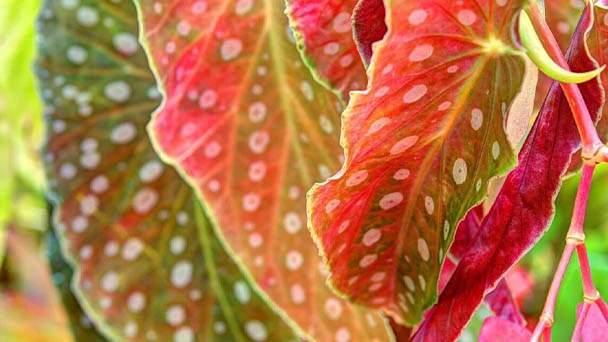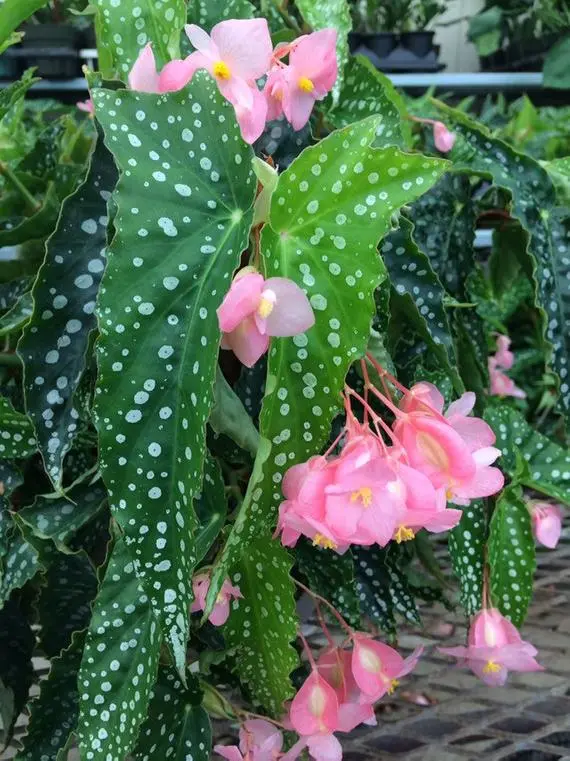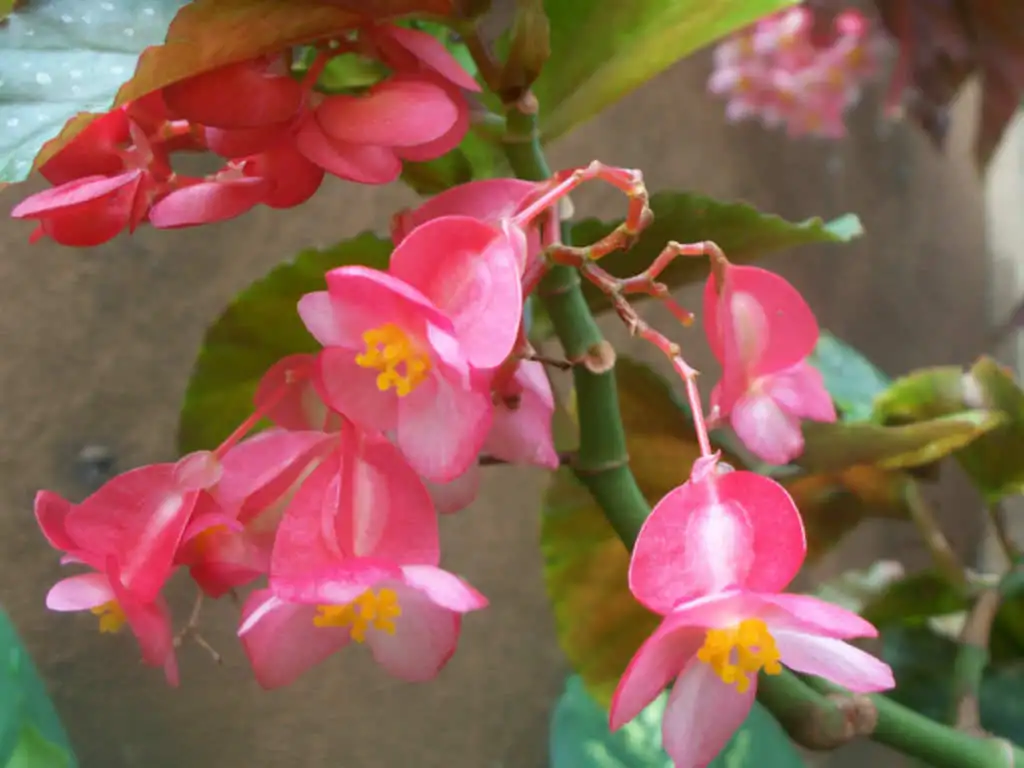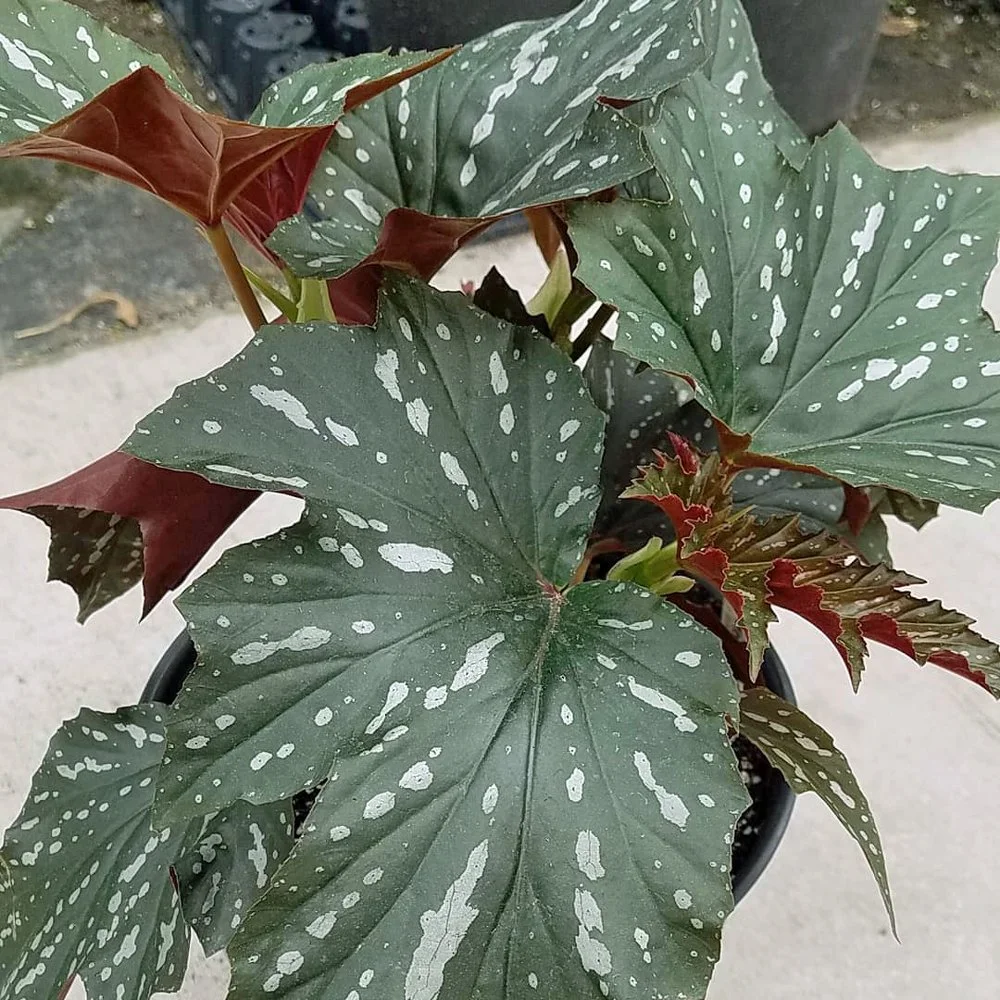How to Grow and Propagate Angel Wing Begonia Indoors
Written by Ivy
Nov 16 2021

Angel Wing Begonia is a small and medium-sized potted plant. Angel wing Begonia has upright and natural plant shape, large and beautiful leaves, flowers like hanging bells, gorgeous color and early flowering period. It is an excellent flower for indoor flower viewing and leaf appreciation. Angel wing Begonia can be displayed on several high shelves or on the desk in front of the window.
Angel wing Begonia is a potted flower very suitable for indoor cultivation. It likes a cool environment with scattered light, and can also be combined with other flowers for cultivation. Angel wing Begonia is actually a tropical perennial flower, which is very suitable for indoor potted maintenance. If properly maintained, it can bloom every year.

Angel wing Begonia potted plants like high air humidity. When raised indoors, we should pay attention to spraying water around regularly or turning on humidifier.
For the indoors propagation of angel wing Begonia in winter, the most important thing to pay attention to is the humidity of angel wing Begonia. Because the indoor air is usually dry, you can put some pebbles on the tray and pour water into the tray. The water level should not exceed the pebbles. In Angel Wing Begonia, you can put them on the pebbles, which is conducive to increasing the air humidity.
Organic liquid fertilizer is the best fertilizer. Ordinary chemical fertilizer is easy to be sensitive to angel wing Begonia. Stacking fertile soil or organic liquid fertilizer can promote the flowering and growth of angel wing Begonia indoors. Angel wing Begonia will stop fertilizing after it gets cold in autumn, and will not fertilize at all in winter.
When we change the basin for angel wing Begonia, we should use fertile soil with good looseness. The pH value of the soil should be about 6.5-7.5, not alkaline soil. The commonly used soil is rotten leaf soil, compost soil or charcoal soil, and the soil cannot harden too easily, otherwise it is not conducive to plant rooting. If the soil used by angel wing Begonia is not suitable, its stems and leaves will grow very short and easy to get sick.
Angel wing Begonia likes water, but doesn't like particularly humid and airless environment. In addition, we should avoid long-term residual water on the leaves. We'd better water it in the morning and evaporate it at night.
If you want to prevent Angel Wing Begonia from being infected with powdery mildew, you can spray fungicides on potted Begonia every 2-3 weeks. You can use common carbendazim, methyltobuzin or mancozeb solution (spray evenly on leaf surface, leaf back and plant).
If we find that the leaf edge of angel wing Begonia cultured indoors turns black brown and has very clear marks, it is usually caused by excessive drying of the air or too strong illumination, or it may be that it has not been supplemented with water for a long time, which will also lead to the drying of the leaf edge.
In order to make angel wing Begonia recover better, it is necessary to move it to a place without sunshine exposure in time, give soft scattered light, and water it in time to avoid the air humidity below 40% for a long time.
Angel wing Begonia blooms less and less, which is usually caused by insufficient light. If it is found that the leaves of Begonia grow relatively tender, the edges of the leaves are dark red, the gap between the branches and leaves continues to elongate, and the leaves gradually grow delicate, it is a lack of light.
Angel wing Begonia, who lacks light, should gradually move to a position with appropriate scattered light. Don't sun too much at once. Gradually increase the light and avoid exposure. We should also pay attention not to supplement angel wing begonia with too much nitrogen fertilizer, otherwise it will also reduce flowering.
When we prune the leaves of angel wing Begonia, we basically cut off half of the petiole. It is recommended to use a blade or a particularly sharp and flat knife to cut the petiole directly. When cutting, we can cut it obliquely or horizontally. The key is to ensure that the pruning tools are sterile. We can spray some alcohol in advance to achieve the effect of disinfection.
Next, we need to prepare the container and soil of angel wing Begonia propagation from cutting. We can use peat soil, perlite and vermiculite in the ratio of 1:1:1, peat soil and perlite in the ratio of 1:1, or pure vermiculite.
Preventive Methods
Angel wing Begonia is not very receptive to strong light, so don't let the light shine directly on the plants in summer. Put angel wing Begonia in a cool place indoors, and you can't directly irradiate strong light in autumn. Therefore, we must avoid the sun at noon and pay attention to shading.
Angel wing Begonia has high requirements for humidity, but is afraid of ponding. Therefore, during maintenance, we must pay attention not to ponding in the basin. In autumn, the temperature will become lower. At this time, the evaporation speed is not as fast as that in summer, so watering must be controlled. If there is too much water, the root system will rot and the natural leaves will turn yellow.
We must have sufficient nutrition during the indoor maintenance of angel wing Begonia, so we need to apply fertilizer once in about 15 days. If the fertilizer is not enough, the leaves will turn yellow. This proves that the nutrition supply is insufficient, and the color of the leaves will gradually fade.
During the indoor maintenance of angel wing Begonia, we must look at the back of the leaves from time to time. If we see insects, we must remove them in time. Choose the appropriate medicine to spray, so as to avoid leaf curling and yellowing.
Preventive Methods
It's best to move angel wing Begonia to the house in autumn or winter, but you can take them out to bask in the sun when there is sunshine in the morning and evening. Although in the house, we must pay attention to the temperature. The temperature should not be lower than 12 ℃, mainly because they are not cold resistant.
In winter, the indoor temperature is actually relatively low. Don't fertilize at this time. When watering at the same time, we must control the amount of water, so as to prevent rotten roots and leaves from falling off. When we maintain angel wing Begonia indoors, we can spray water on the leaf surface with a watering can in about six days. In this way, the humidity of the leaves is maintained, and there will be no falling off.
Angel wing Begonia is a potted flower very suitable for indoor cultivation. It likes a cool environment with scattered light, and can also be combined with other flowers for cultivation. Angel wing Begonia is actually a tropical perennial flower, which is very suitable for indoor potted maintenance. If properly maintained, it can bloom every year.
Angel Wing Begonia Quick InfoWhen to Plant Angel Wing BegoniaWhen does Angel Wing Begonia Bloom & HarvestAngel Wing Begonia Care in DetailAngel Wing Begonia WateringAngel Wing Begonia SoilAngel Wing Begonia LightAngel Wing Begonia TemperatureAngel Wing Begonia HumidityAngel Wing Begonia FertilizerAngel Wing Begonia PruningAngel Wing Begonia RepottingAngel Wing Begonia Pest & Disease ControlAngel Wing Begonia PropagationAngel Wing Begonia Propagation from CuttingAngel Wing Begonia Propagation from SeedAngel Wing Begonia Indoors Care FAQsAngel wing Begonia leaves are yellow and curlyAngel Wing Begonia roots rot and the leaves fall off
Angel Wing Begonia Quick Info
| Botanical/Scientific Name | Begonia Angel Wing |
| Common Name | Angel Wing Begonia |
| Uses | Medicinal uses |
| Origin | California |
| Light Care | Partial shade |
| Soil Care | Moist but well-drained |
| Temperature Care | 65°-75°F (18.3°-23.9°C) |
| Humidity Care | Typically humid room in your home |
| Watering | Frequent watering |
| Pruning Care | Prune your shade begonias for size and maintenance in spring |
| Fertilizer Care | Balanced 8-8-8 fertilizer |
| Propagation | Take cuttings for propagation |
| Toxic | Poisonous to cats, dogs, and small children |
| Flower Color | Bright red to light pink in color |

When to Plant Angel Wing Begonia
Angel wing Begonia can be planted in spring or autumn. Generally, the seeds are collected in August, and can be planted after seed collection. If it is to be planted in spring, sand storage should be carried out in winter. Angel wing Begonia seeds will germinate in about a month. Sometimes if they grow slowly, they may need to wait about 40 days. In addition, angel wing Begonia transplantation was also performed in spring.When does Angel Wing Begonia Bloom & Harvest
Generally speaking, Angel Wing Begonia blooms from July to September every year. Angel wing Begonia has pink flowers, delicate and lovely flowers, oblong bracts and a large number of flowers. Angel wing Begonia flowers have very high ornamental value.Angel Wing Begonia Care in Detail
Angel Wing Begonia Watering
When indoors propagating angel wing Begonia, we can't water it from leaves or flowers, but directly in the soil. In daily maintenance, water should be poured every two days during the growth period, and frequently in summer. If the climate is dry, water can be poured twice a day. Generally, the newly purchased angel wing Begonia should not be watered immediately until it adapts to the environment. For angel wing Begonia who wants to change the basin, it is generally possible to pour water once after changing the basin.Angel Wing Begonia Soil
For Angel Wing Begonia planted indoors, we should ensure loose, breathable and well drained humus soil. The soil should be rich in humus. We can mix peat soil with perlite, add some slow-acting organic granular fertilizer in the basin, and add some vermiculite in the soil.Angel Wing Begonia Light
Angel wing Begonia likes bright scattered light. It is more suitable to keep it on the indoor windowsill or the balcony facing west. Angel wing Begonia doesn't like exposure to the sun or direct light. It likes a semi cloudy and semi sunny environment. It's best to keep it indoors in summer. We can put angel wing Begonia in a slightly shaded place to avoid direct sunlight.Angel Wing Begonia Temperature
Angel Wing Begonia is suitable for growing in the temperature environment of 19-24 ℃, and the minimum temperature in winter should also be kept above 10 ℃. If it is lower than 10 ℃, the leaves are very vulnerable to cold, but the rhizomes of angel wing Begonia are relatively cold resistant.Angel Wing Begonia Humidity
When maintaining potted angel wing Begonia indoors, it is still necessary to maintain high air humidity.Angel wing Begonia potted plants like high air humidity. When raised indoors, we should pay attention to spraying water around regularly or turning on humidifier.
For the indoors propagation of angel wing Begonia in winter, the most important thing to pay attention to is the humidity of angel wing Begonia. Because the indoor air is usually dry, you can put some pebbles on the tray and pour water into the tray. The water level should not exceed the pebbles. In Angel Wing Begonia, you can put them on the pebbles, which is conducive to increasing the air humidity.
Angel Wing Begonia Fertilizer
Angel wing Begonia can only give fertilizer appropriately in spring and summer. After spring is warm, the concentration of fertilizer given for the first time is lower than usual, and the concentration is 1 / 4 of the usual. In this way, it can be fertilized normally after maintenance for about three weeks.Organic liquid fertilizer is the best fertilizer. Ordinary chemical fertilizer is easy to be sensitive to angel wing Begonia. Stacking fertile soil or organic liquid fertilizer can promote the flowering and growth of angel wing Begonia indoors. Angel wing Begonia will stop fertilizing after it gets cold in autumn, and will not fertilize at all in winter.
Angel Wing Begonia Pruning
Angel wing Begonia doesn't need much attention for indoor pruning. It is usually pruned regularly to avoid angel wing Begonia growing too messy. If you see withered branches and leaves, you should cut them off, and when the flowers wither.
Angel Wing Begonia Repotting
The best time for Angel Wing Begonia to be repotted is in spring. Spring is its budding season. At this time, its new roots have not grown, and the damage to the roots is very small. Angel wing Begonia can also change pots in autumn. The temperature in autumn is not so muggy, and the ambient temperature is also very suitable for changing pots. Try not to change pots in summer.When we change the basin for angel wing Begonia, we should use fertile soil with good looseness. The pH value of the soil should be about 6.5-7.5, not alkaline soil. The commonly used soil is rotten leaf soil, compost soil or charcoal soil, and the soil cannot harden too easily, otherwise it is not conducive to plant rooting. If the soil used by angel wing Begonia is not suitable, its stems and leaves will grow very short and easy to get sick.
Angel Wing Begonia Pest & Disease Control
If angel wing Begonia is propagation indoors in an excessively dark environment, and the leaves are often wet and there is often water residue on the leaf surface, angel wing Begonia is prone to powdery mildew. The symptom is that white or gray powdery spots or patches will appear on the leaf surface. Once we see this angel wing Begonia disease, we need to control the environmental humidity and avoid frequent wetting of the leaves.Angel wing Begonia likes water, but doesn't like particularly humid and airless environment. In addition, we should avoid long-term residual water on the leaves. We'd better water it in the morning and evaporate it at night.
If you want to prevent Angel Wing Begonia from being infected with powdery mildew, you can spray fungicides on potted Begonia every 2-3 weeks. You can use common carbendazim, methyltobuzin or mancozeb solution (spray evenly on leaf surface, leaf back and plant).
If we find that the leaf edge of angel wing Begonia cultured indoors turns black brown and has very clear marks, it is usually caused by excessive drying of the air or too strong illumination, or it may be that it has not been supplemented with water for a long time, which will also lead to the drying of the leaf edge.
In order to make angel wing Begonia recover better, it is necessary to move it to a place without sunshine exposure in time, give soft scattered light, and water it in time to avoid the air humidity below 40% for a long time.
Angel wing Begonia blooms less and less, which is usually caused by insufficient light. If it is found that the leaves of Begonia grow relatively tender, the edges of the leaves are dark red, the gap between the branches and leaves continues to elongate, and the leaves gradually grow delicate, it is a lack of light.
Angel wing Begonia, who lacks light, should gradually move to a position with appropriate scattered light. Don't sun too much at once. Gradually increase the light and avoid exposure. We should also pay attention not to supplement angel wing begonia with too much nitrogen fertilizer, otherwise it will also reduce flowering.

Angel Wing Begonia Propagation
Begonia propagation is also very simple. Generally, it is cut by branches, and occasionally by leaves. During propagation, pay attention to maintaining high air humidity. Prepare cutting propagation with sand or perlite, keep it moist, and the temperature is about 20 degrees, so it is easy to take root and sprout. When cutting, angel wing Begonia branches can be stained with some rooting powder at the end, which makes it easier to take root.Angel Wing Begonia Propagation from Cutting
Before angel wing begonia propagation from cutting, we must select the leaves. On the whole pot of Begonia, we should choose the leaves that are strong, full and young. Do not choose the new leaves that are too tender or the leaves that are too old at the bottom, otherwise we will not succeed in leaf insertion.When we prune the leaves of angel wing Begonia, we basically cut off half of the petiole. It is recommended to use a blade or a particularly sharp and flat knife to cut the petiole directly. When cutting, we can cut it obliquely or horizontally. The key is to ensure that the pruning tools are sterile. We can spray some alcohol in advance to achieve the effect of disinfection.
Next, we need to prepare the container and soil of angel wing Begonia propagation from cutting. We can use peat soil, perlite and vermiculite in the ratio of 1:1:1, peat soil and perlite in the ratio of 1:1, or pure vermiculite.
Angel Wing Begonia Propagation from Seed
Angel wing Begonia propagation from seed is relatively simple. First prepare a shallow tile pot and put the sterilized soil into the flower pot. A layer of tiles should be placed at the bottom of the basin to increase air permeability. We need to buy some high-quality angel wing Begonia seeds, and then sow the seeds on the basin soil without covering the soil. Finally, the basin immersion method is used for water replenishment, which can not be watered directly. Then it is put into the semi shade and sprayed with water appropriately every day.Angel Wing Begonia Indoors Care FAQs
Angel wing Begonia leaves are yellow and curly
The yellowing of its leaves during the growth period of angel wing Begonia may be due to the direct irradiation of strong light on the plants or too much water during watering. In fact, this phenomenon occurs when the concentration of fertilization is too high and there are diseases and pests. The leaves not only turn yellow, but also curl. At this time, how to prevent angel wing Begonia from turning yellow? We can use the following methods.Preventive Methods
Angel wing Begonia is not very receptive to strong light, so don't let the light shine directly on the plants in summer. Put angel wing Begonia in a cool place indoors, and you can't directly irradiate strong light in autumn. Therefore, we must avoid the sun at noon and pay attention to shading.
Angel wing Begonia has high requirements for humidity, but is afraid of ponding. Therefore, during maintenance, we must pay attention not to ponding in the basin. In autumn, the temperature will become lower. At this time, the evaporation speed is not as fast as that in summer, so watering must be controlled. If there is too much water, the root system will rot and the natural leaves will turn yellow.
We must have sufficient nutrition during the indoor maintenance of angel wing Begonia, so we need to apply fertilizer once in about 15 days. If the fertilizer is not enough, the leaves will turn yellow. This proves that the nutrition supply is insufficient, and the color of the leaves will gradually fade.
During the indoor maintenance of angel wing Begonia, we must look at the back of the leaves from time to time. If we see insects, we must remove them in time. Choose the appropriate medicine to spray, so as to avoid leaf curling and yellowing.
Angel Wing Begonia roots rot and the leaves fall off
The root leaf shedding of angel wing Begonia usually occurs in a cold environment. This phenomenon will occur in autumn and winter if you do not pay attention to the temperature control. Although they prefer the cold environment, their bearing capacity is very low, that is to say, they are not cold resistant. Therefore, angel wing Begonia must be taken indoors for maintenance in autumn. If the indoor temperature is relatively low, pay attention to the amount of water. If there is too much water, it will cause root rot.Preventive Methods
It's best to move angel wing Begonia to the house in autumn or winter, but you can take them out to bask in the sun when there is sunshine in the morning and evening. Although in the house, we must pay attention to the temperature. The temperature should not be lower than 12 ℃, mainly because they are not cold resistant.
In winter, the indoor temperature is actually relatively low. Don't fertilize at this time. When watering at the same time, we must control the amount of water, so as to prevent rotten roots and leaves from falling off. When we maintain angel wing Begonia indoors, we can spray water on the leaf surface with a watering can in about six days. In this way, the humidity of the leaves is maintained, and there will be no falling off.
Latest Updated
- Benefits of Bugleweed - 7 Science-backed Health Benefits
- Bugleweed Dangers & Side Effects - Is It Poisonous?
- How to Plant Evergreen Trees - What You Should Know
- When to Plant Evergreens - Grow Guide for Evergreen Trees
- 12 Wonderful Evergreen Shrubs for Your Garden
- 12 Popular Evergreen Plants with Pictures for Beginners
- When And How To Prune A Lilac Bush Like a Pro
- How to Grow & Care for Lilac Vine (Hardenbergia Violacea)
- Japanese Lilac Tree (Syringa Reticulata) Care & Propagation Guide
- Shumard Oak Pros and Cons - What to Know
Popular Articles
- Winter maintenance of Antirrhinum Majus
- How to Grow Terminalia Mantaly Tree
- How to Grow and Care for Crossostephium Chinense
- How to grow Antirrhinum Majus in spring
- Peristeria Elata (Dove Orchid) Profile: Info & Care Guide
- Underwatered Snake Plant (Sansevieria Trifasciata) - Signs And How To Fix
- How to Care for Brazilian Jasmine Plant (Mandevilla Sanderi)
- How to Grow & Care for Graptopetalum Purple Delight in Summer
- Rosa Chinensis (China Rose): Plant Growing & Care Tips
- How to Care for Baby Sun Rose (Aptenia Cordifolia)